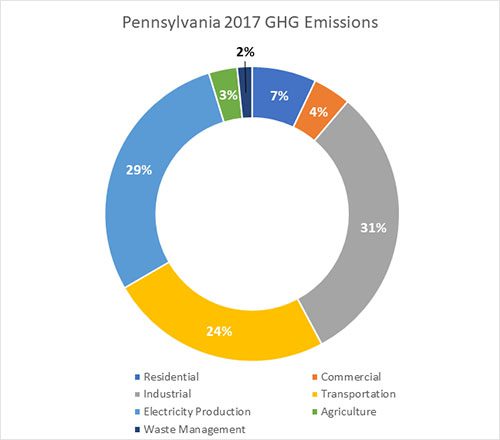Decarbonizing Pennsylvania

The Path to Deep Decarbonization in Pennsylvania
July 6, 2021– The climate crisis is accelerating and intensifying. An alarming new analysis released in mid-June by NASA and NOAA found that the planet is trapping roughly double the amount of heat in the atmosphere that it did just 15 years ago. We know that climate tipping points could trigger other climate tipping points in a domino effect, leading to irreversible impacts. Earth has already warmed roughly 1.1 degrees Celsius since the 19th century. Even if we magically zeroed out all greenhouse gas (GHG) emissions tomorrow, that warming is baked in for decades. Thankfully, we have the tools available to save lives and prevent the worst impacts from being felt. But we need to enact sweeping policy changes now and over the course of this decade to make that happen.
In Pennsylvania, historically a major fossil fuel state, key sources of GHG pollution can be broken down into these categories:
- electricity generators (coal-fired and fracked gas-fired power plants);
- industrial activities (e.g., fracked gas extraction and processing, iron and steel production, cement manufacturing);
- transportation sources;
- residential and commercial buildings, and
- agriculture
To oversimplify things, here’s a two-step path to dramatically curb emissions: (1) decarbonize the electricity sector; and (2) then electrify everything. There will be countless complementary policy measures needed to implement that plan (and not everything can be easily electrified) but it’s a solid framework to guide our efforts.
To help decarbonize Pennsylvania’s electric sector, Governor Wolf directed the Department of Environmental Protection (PADEP) to draft rules to establish a CO2 Budget Trading Program and allow the Commonwealth to participate in the Regional Greenhouse Gas Initiative (RGGI) beginning in 2022. RGGI is a collaborative effort between 11 neighboring states that uses a market-based auction approach to put a price on carbon for polluting power plants. RGGI states have seen their power sector carbon pollution cut in half since 2009. PADEP projects that RGGI participation will cut up to 227 million tons of CO2 by 2030, while generating hundreds of millions of dollars in annual proceeds for reinvestment in Pennsylvania businesses and communities. This is a strong first step.
Pennsylvania would also benefit from President Biden’s proposed Energy Efficiency and Clean Electricity Standard (EECES) – which aims to fully decarbonize America’s electricity sector by 2035 – and by the U.S. Environmental Protection Agency’s (EPA) plans to reinstate a strengthened version of President Obama’s Clean Power Plan. In March, Governor Wolf also announced a major public-private partnership (called “PULSE”) to install seven new solar arrays in counties across Pennsylvania that will supply nearly half the electricity used by state government. This project will go into operation beginning January 1, 2023, and represents the largest commitment to solar energy by any government in the U.S. That’s a decent start for the electricity sector.
Pennsylvania also needs to significantly invest in expanding our electric vehicle (EV) charging infrastructure and accelerate consumer knowledge and adoption of EVs. In February, PADEP announced it intends to promulgate a proposed Zero Emission Vehicle (ZEV) rulemaking later this year, which would require automakers and dealerships in Pennsylvania to sell a certain amount of electric cars and trucks. However, it’s not enough to simply change motors in the vehicles we drive. We need to incentivize transportation mode shifting by making substantial investments in public transit, railways, bike trails, and walkable corridors in our cities and suburbs.
On the industrial side, Pennsylvania is the second-largest fracked gas producing state in the country. Our gas industry emits over 1.1 million tons of methane pollution every year. Methane, the primary component of fracked gas, is an extremely potent climate pollutant and leaks across every stage of the gas supply chain. PADEP is finalizing a rulemaking to control methane emissions from existing infrastructure (well sites, compressor stations, and processing plants), but the proposal currently exempts so-called “low-producing” wells from routine inspection requirements. In practice, this means over half the methane emissions from existing sources will continue to go unchecked. Clean Air Council helped deliver tens of thousands of comments during the public comment period last year urging PADEP to close this loophole.
The Biden EPA is also planning to draft federal methane rules for existing sources, which we anticipate seeing introduced as early as September 2021. Those have enormous potential to reduce Pennsylvania emissions. So too would the $16 billion called for by President Biden in his American Jobs Plan to plug orphaned wells and clean up abandoned mine lands. Pennsylvania has hundreds of thousands of orphaned gas wells (the vast majority of which aren’t even documented) that desperately need funding to plug up methane that’s been leaking for decades.
Finally, about 11% of Pennsylvania’s GHG pollution comes from burning fossil fuels to heat space and water in our residential homes and commercial buildings. In Philadelphia, our building stock contributes more than 70% of the city’s GHG emissions. We need to move quickly to incentivize all-electric construction in new buildings, while taking bold steps to retrofit and electrify our existing buildings. This can happen at the municipal level, where Philadelphia is conducting a Diversification Study to examine the future of Philadelphia Gas Works, the nation’s largest municipally owned fracked gas utility. It can also happen at the federal level, where another key component of President Biden’s American Jobs Plan would invest billions in retrofitting our nation’s homes and buildings.
Clean Air Council has been directly involved in all the various legal and policy issues surrounding these plans in the past year. There is so much that needs to happen and quickly. Thankfully, we have a solid grasp on how to reach our goals and these multifaceted efforts should work in tandem to drive down emissions. It’ll be the challenge of our lifetimes, and it’s already begun.
For more information, please contact:
Robert M. Routh, Esq.
Public Policy and Regulatory Attorney
rrouth@cleanair.org

